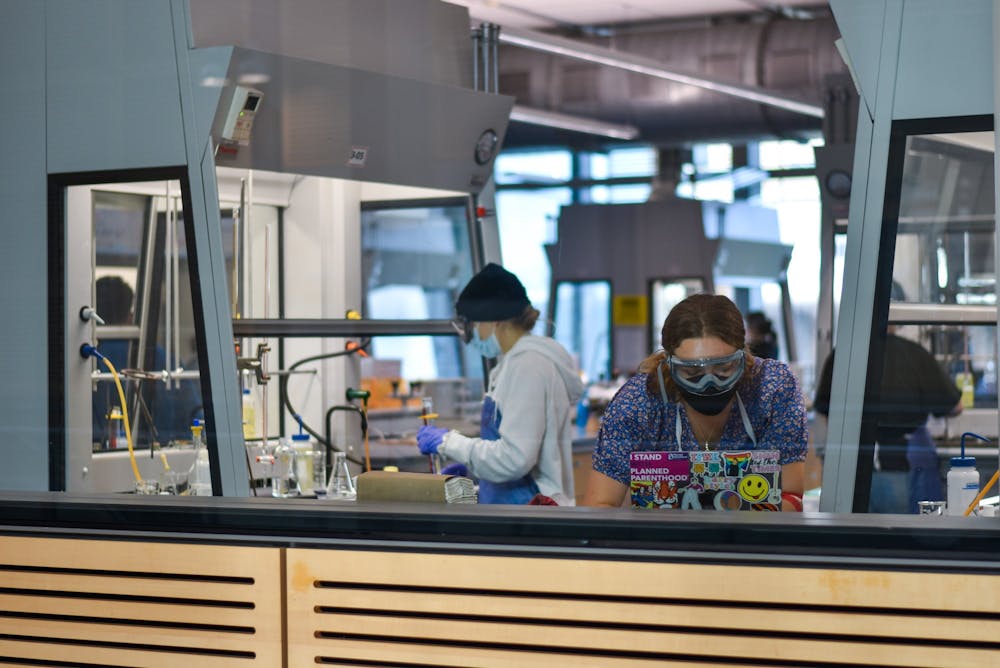As the COVID-19 virus continues to pose a dynamic threat worldwide, University researchers are studying the enigmatic properties of the virus. Recently, Princeton chemists and molecular biologists identified eight new entry points the COVID-19 spike protein exploits to penetrate the cell surface and successfully infect cells. Out of these eight newly discovered candidate receptors, the scientists found that four are vital to enabling viral COVID-19 infection.
This latest research was co-led by James S. McDonnell Distinguished University Professor of Chemistry and 2021 Nobel Laureate in Chemistry David MacMillan and Professor of Molecular Biology Alexander Ploss. The collaborative, interdisciplinary enterprise began in the throes of the COVID-19 pandemic when information about the virus was still tentative and evolving.
Their recent work, presented in a paper titled “Photochemical Identification of Auxiliary Severe Acute Respiratory Syndrome Coronavirus 2 Host Entry Factors Using μMap,” was published in the Journal of the American Chemical Society on Sept. 1.
In 2020, scientists determined that the SARS-CoV-2 virus spike protein infiltrates lung cells using an enzyme known as ACE2 as its primary means of viral entry and replication.
However, in an email to The Daily Princetonian, MacMillan emphasized that the jury was still out as to whether the ACE2 receptor was the only entryway for the COVID-19 spike protein. MacMillan, Ploss, and a team of University researchers speculated that alternative entry points could exist, a possibility that has motivated their current work.
“Our guess ended up being correct, and using our µMap technology we were able to discover these hard-to-find interactions that are potential key players in COVID pathology,” wrote MacMillan and Dr. Steve Knutson, a postdoctoral researcher in the MacMillan Group and one of the paper’s co-authors, in a joint statement to the ‘Prince.’
Pioneered by the MacMillan lab in 2020, µMap — or micromap — represents a versatile cellular mapping technology that leverages proximity and rapid timing to map complex biomolecular interactions with unparalleled resolution. The technology relies on a class of molecules termed “photocatalysts,” which respond to light activation by catalyzing chemical reactions.
In the present research context, the researchers integrated the photocatalysts onto the COVID-19 spike protein to detect and tag potential receptor sites in close proximity to the ACE2 receptor. According to Ploss, µMap’s “very tight labeling radius” precisely pinpointed eight receptor candidates that the COVID-19 spike protein interacted with to gain entry into cells.

After identifying these possible receptor sites, the researchers probed the functional relevance of the eight protein receptors by separately expressing each of them on the surface of human lung cells.
The researchers then generated SARS-CoV-2 virus pseudoparticles to characterize the interactions between the COVID-19 spike protein and each receptor, as well as to quantify the extent of viral entry. The pseudoparticles, which enter cells in the same way as actual COVID-19 spike proteins, are devoid of genetic material and thus cannot replicate to infect the cell.
Instead, the pseudoparticles are embedded with reporter genes that encode vivid fluorescent proteins so they are more easily detected.
“This turned out to be a helpful tool as we were able to uncouple viral entry from the downstream steps in the SARS-CoV2 life-cycle. It is also a safe way to study SARS-CoV2 uptake mechanisms without having to use infectious SARS-CoV2, which is a hazardous pathogen,” Ploss wrote in an email to the ‘Prince.’

Based on the pseudoparticle findings, the researchers determined that four of the eight candidate protein receptors exhibited significant evidence of viral entry, a finding Ploss described as “not entirely surprising.”
“Other viruses rely on multiple host factors [for] entry into their respective host cells, [like] hepatitis C virus, [which] engages with at least 7-8 molecules to enter into [liver cells],” he said in the email.
During the course of conducting this research, the scientists encountered their fair share of challenges.
“Just as with all research projects, we certainly encountered difficulty in generating initial results and building a robust technology platform. It was also a bit challenging to individually test out each potential candidate receptor, but these obstacles proved surmountable and yielded some exciting results,” the team told the ‘Prince.’
Furthermore, when the lab first began the project in 2020, University COVID-19-related measures restricted facility access, according to Ploss, and they continue to experience challenges as they pursue this research.
“Although our current study lays the groundwork for discovering SARS-CoV-2 entry mechanisms, our results did focus on the original Wuhan strain of the virus,” wrote MacMillan and Knutson.
“We’re unfortunately still experiencing the COVID-19 pandemic in real time as more and more variants and sub-variants evolve around the world. We would certainly be very interested in using µMap to understand this evolution and how it connects with the host-virus interface,” they wrote.
Ploss emphasized that the identification of new entry points for the virus opens doors to devising new treatments in the future that could prevent the COVID-19 virus from gaining a foothold in cells in the first place.
“Viral entry is a crucial step in the lifecycle of any virus and thus blocking this step may indeed be an effective way of combating SARS-CoV2,” he wrote.
Amy Ciceu is a senior writer who often covers research and COVID-19-related developments. She also serves as a Newsletter Editor. She can be reached at aciceu@princeton.edu.








